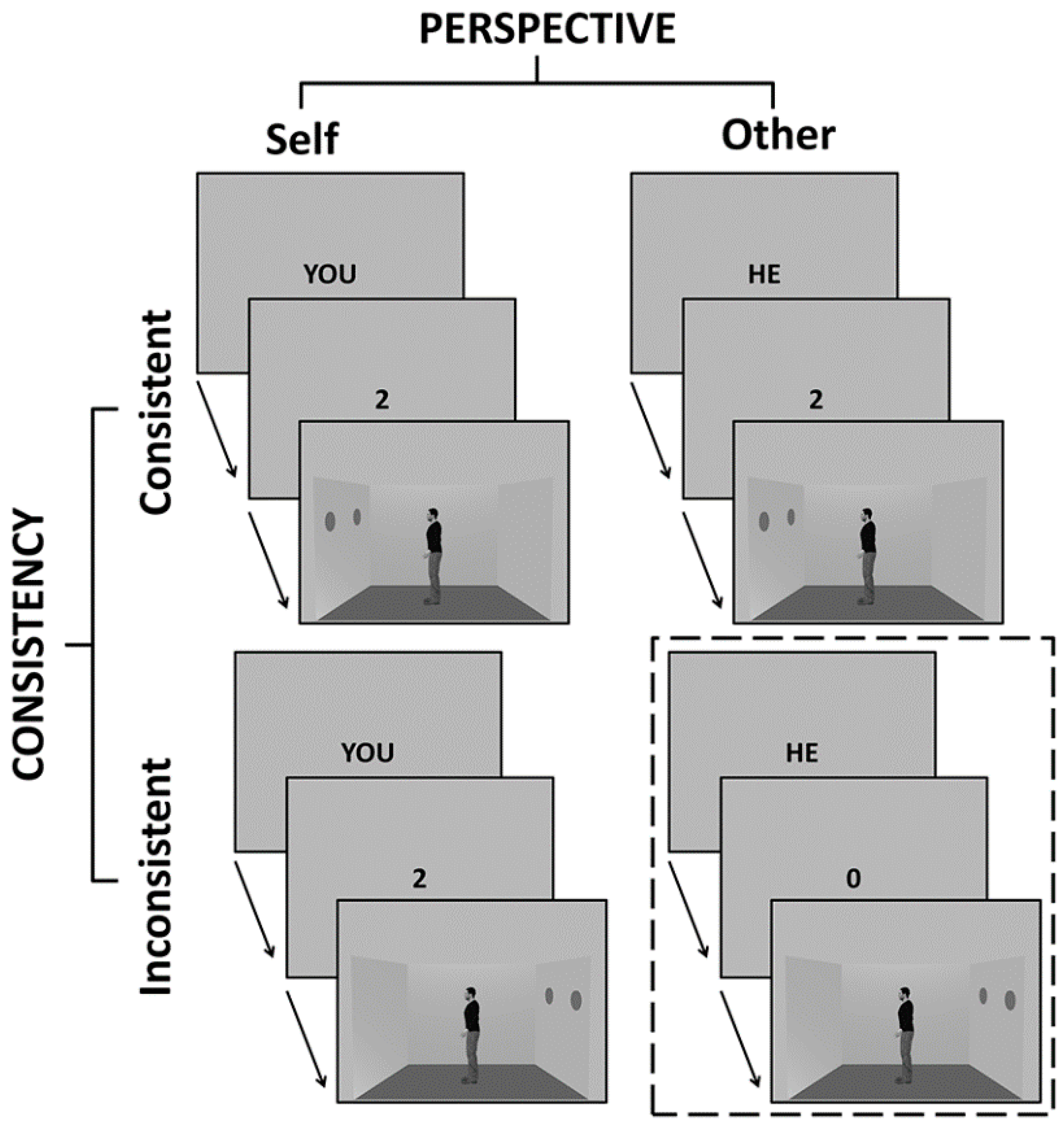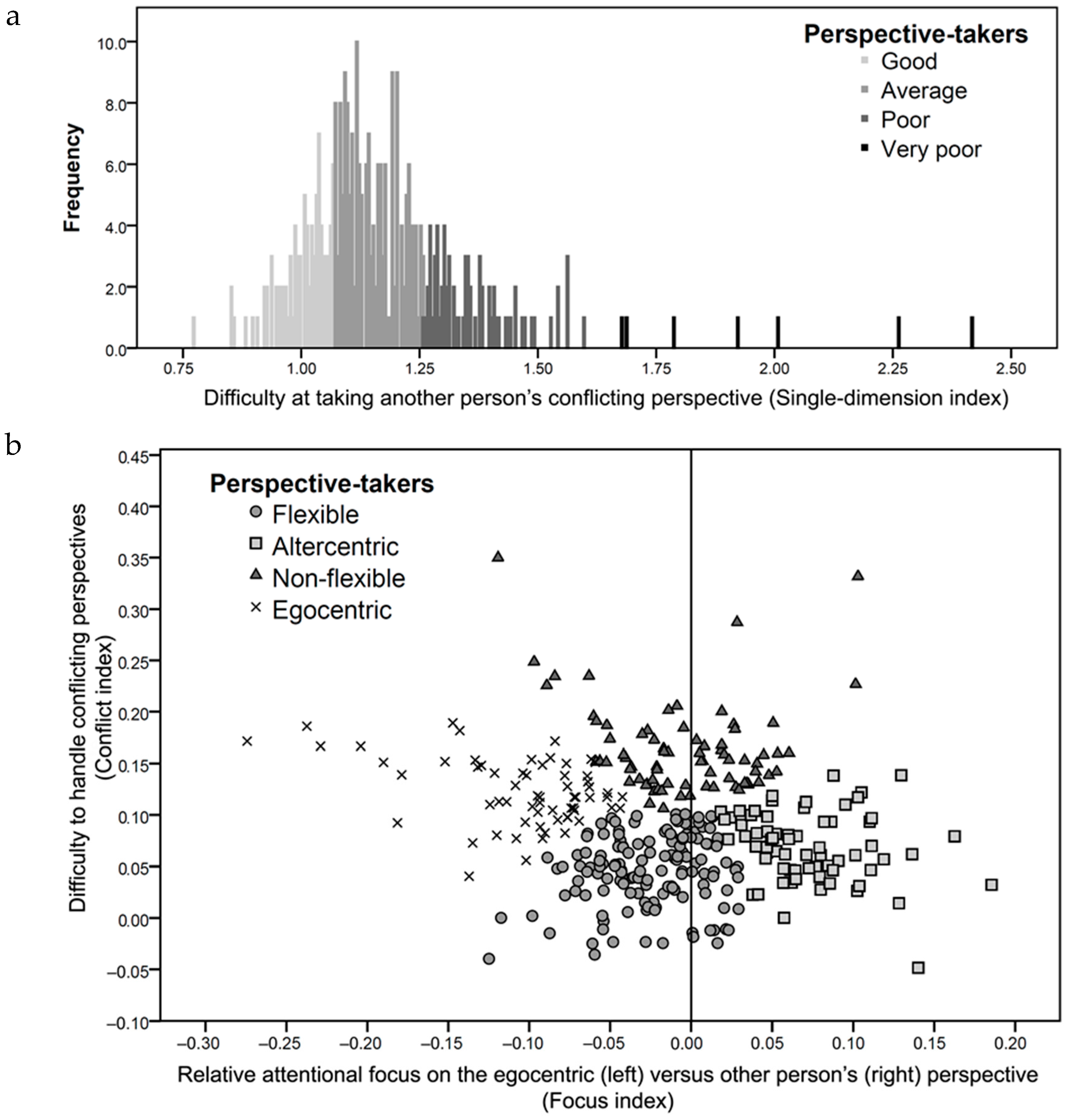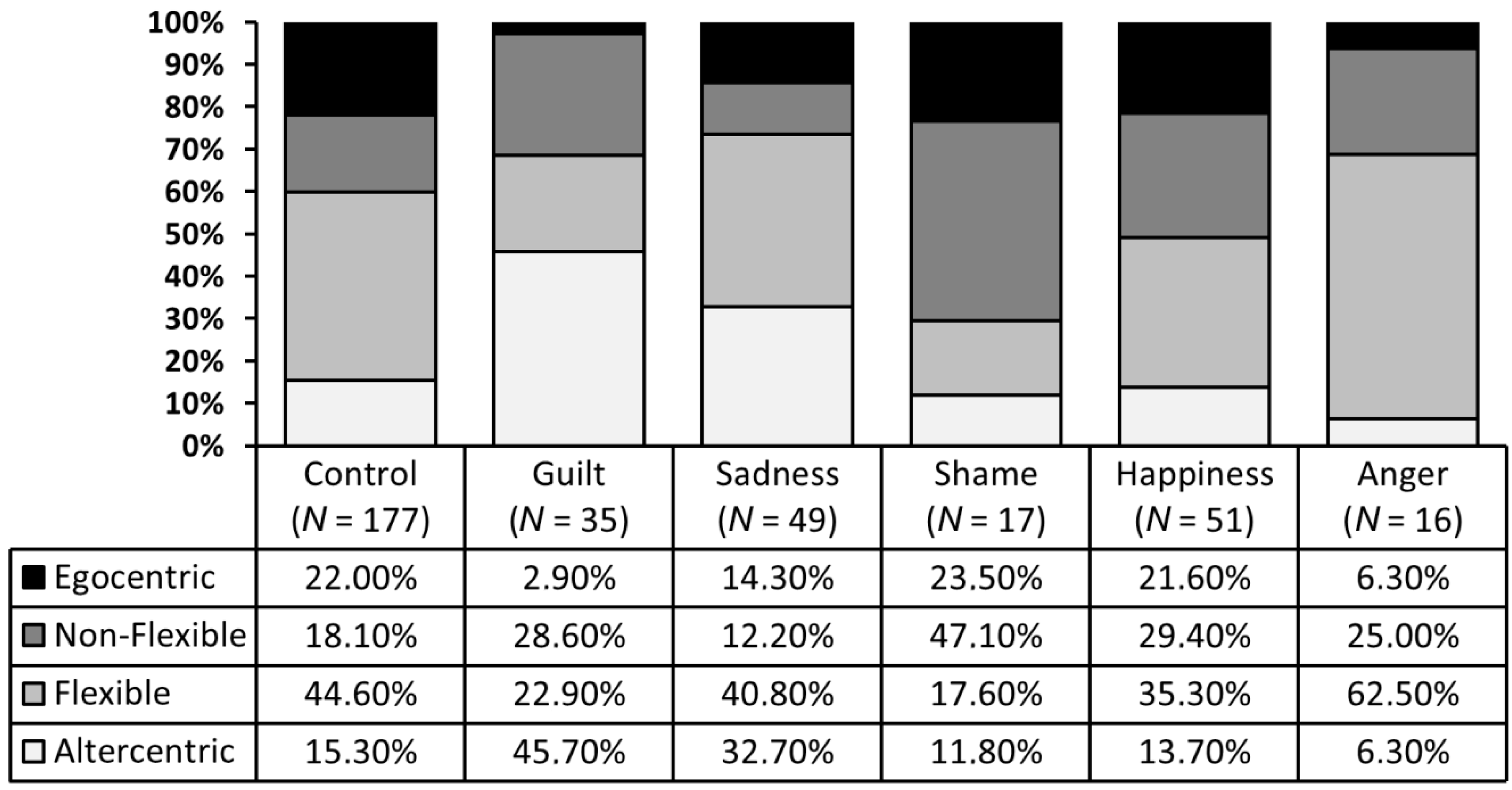New Insights into the Inter-Individual Variability in Perspective Taking
Abstract
:1. Introduction
2. Results
2.1. One-Dimensional Cluster Analysis
2.2. Two-Dimensional Cluster Analysis
2.3. Predicting Self-Reported Everyday Life Perspective-Taking Propensity with One-Dimensional versus Two-Dimensional Measures
2.4. Comparison of the One-Dimensional and Two-Dimensional Profiles
2.5. Distribution of Profiles across Emotion Induction Conditions
3. Discussion
4. Materials and Methods
4.1. Participants
4.2. Instruments
4.2.1. Visual Perspective-Taking Task
4.2.2. Perspective-Taking Propensity
4.3. Data Analyses
4.3.1. Indexes Computation
4.3.2. Cluster Analyses
4.3.3. Regression Analyses
4.3.4. Tests of Independence
5. Conclusions
Supplementary Materials
Acknowledgments
Author Contributions
Conflicts of Interest
References and Notes
- Lawrence, E.J.; Shaw, P.; Baker, D.; Baron-Cohen, S.; David, A.S. Measuring Empathy: Reliability and Validity of the Empathy Quotient. Psychol. Med. 2004, 34, 911–919. [Google Scholar] [CrossRef] [PubMed]
- Davis, M.H. Measuring Individual Differences in Empathy: Evidence for a Multidimensional Approach. J. Personal. Soc. Psychol. 1983, 44, 113–126. [Google Scholar] [CrossRef]
- Grynberg, D.; Luminet, O.; Corneille, O.; Grèzes, J.; Berthoz, S. Alexithymia in the Interpersonal Domain: A General Deficit of Empathy? Personal. Individ. Differ. 2010, 49, 845–850. [Google Scholar] [CrossRef]
- Dewaele, J.-M.; Wei, L. Multilingualism, Empathy and Multicompetence. Int. J. Multiling. 2012, 9, 352–366. [Google Scholar] [CrossRef]
- Rizkalla, L.; Wertheim, E.H.; Hodgson, L.K. The Roles of Emotion Management and Perspective Taking in Individuals’ Conflict Management Styles and Disposition to Forgive. J. Res. Personal. 2008, 42, 1594–1601. [Google Scholar] [CrossRef]
- Langdon, R.; Coltheart, M. Visual Perspective-Taking and Schizotypy: Evidence for a Simulation-Based Account of Mentalizing in Normal Adults. Cognition 2001, 82, 1–26. [Google Scholar] [CrossRef]
- Leith, K.P.; Baumeister, R.F. Empathy, Shame, Guilt, and Narratives of Interpersonal Conflicts: Guilt-Prone People Are Better at Perspective Taking. J. Personal. 1998, 66, 1–37. [Google Scholar] [CrossRef]
- Ryskin, R.A.; Benjamin, A.S.; Tullis, J.; Brown-Schmidt, S. Perspective-Taking in Comprehension, Production, and Memory: An Individual Differences Approach. J. Exp. Psychol. Gen. 2015, 144, 898–915. [Google Scholar] [CrossRef] [PubMed]
- Wardlow, L. Individual Differences in Speakers’ Perspective Taking: The Roles of Executive Control and Working Memory. Psychon. Bull. Rev. 2013, 20, 766–772. [Google Scholar] [CrossRef] [PubMed]
- Birch, S.A.J.; Bloom, P. Understanding Children’s and Adults’ Limitations in Mental State Reasoning. Trends Cogn. Sci. 2004, 8, 255–260. [Google Scholar] [CrossRef] [PubMed]
- Epley, N.; Keysar, B.; van Boven, L.; Gilovich, T. Perspective Taking as Egocentric Anchoring and Adjustment. J. Personal. Soc. Psychol. 2004, 87, 327–339. [Google Scholar] [CrossRef] [PubMed]
- Leslie, A.M.; German, T.P.; Polizzi, P. Belief-Desire Reasoning as a Process of Selection. Cogn. Psychol. 2005, 50, 45–85. [Google Scholar] [CrossRef] [PubMed]
- Perner, J.; Lang, B. Development of Theory of Mind and Executive Control. Trends Cogn. Sci. 1999, 3, 337–344. [Google Scholar] [CrossRef]
- Royzman, E.B.; Cassidy, K.W.; Baron, J. “I Know, You Know”: Epistemic Egocentrism in Children and Adults. Rev. Gen. Psychol. 2003, 7, 38–65. [Google Scholar] [CrossRef]
- Qureshi, A.W.; Apperly, I.A.; Samson, D. Executive Function Is Necessary for Perspective Selection, Not Level-1 Visual Perspective Calculation: Evidence from a Dual-Task Study of Adults. Cognition 2010, 117, 230–236. [Google Scholar] [CrossRef] [PubMed]
- Some recent findings indicate, however, that the capacity to handle conflicting perspectives is not entirely driven by domain-general executive capacities (Hartwright, Apperly, & Hansen, 2015; Samson, Houthuys, & Humphreys, 2015).
- German, T.P.; Hehman, J.A. Representational and Executive Selection Resources in “Theory of Mind”: Evidence from Compromised Belief-Desire Reasoning in Old Age. Cognition 2006, 101, 129–152. [Google Scholar] [CrossRef] [PubMed]
- Lin, S.; Keysar, B.; Epley, N. Reflexively Mindblind: Using Theory of Mind to Interpret Behavior Requires Effortful Attention. J. Exp. Soc. Psychol. 2010, 46, 551–556. [Google Scholar] [CrossRef]
- Newton, A.M.; de Villiers, J.G. Thinking While Talking: Adults Fail Nonverbal False-Belief Reasoning. Psychol. Sci. 2007, 18, 574–579. [Google Scholar] [CrossRef] [PubMed]
- Bernstein, D.M.; Atance, C.; Meltzoff, A.N.; Loftus, G.R. Hindsight Bias and Developing Theories of Mind. Child Dev. 2013, 78, 1374–1394. [Google Scholar] [CrossRef] [PubMed]
- Carlson, S.M.; Moses, L.J.; Claxton, L.J. Individual Differences in Executive Functioning and Theory of Mind: An Investigation of Inhibitory Control and Planning Ability. J. Exp. Child Psychol. 2004, 87, 299–319. [Google Scholar] [CrossRef] [PubMed]
- Carlson, S.M.; Moses, L.J.; Hix, H.R. The Role of Inhibitory Processes in Young Children’s Difficulties with Deception and False Belief. Child Dev. 1998, 69, 672. [Google Scholar] [CrossRef] [PubMed]
- Carlson, S.M.; Moses, L.J. Individual Differences in Inhibitory Control and Children’s Theory of Mind. Child Dev. 2001, 72, 1032–1053. [Google Scholar] [CrossRef] [PubMed]
- Devine, R.T.; Hughes, C. Relations between False Belief Understanding and Executive Function in Early Childhood: A Meta-Analysis. Child Dev. 2014, 85, 1777–1794. [Google Scholar] [CrossRef] [PubMed]
- Fizke, E.; Barthel, D.; Peters, T.; Rakoczy, H. Executive Function Plays a Role in Coordinating Different Perspectives, Particularly When One’s Own Perspective is Involved. Cognition 2014, 130, 315–334. [Google Scholar] [CrossRef] [PubMed]
- Frye, D.; Zelazo, P.D.; Palfai, T. Theory of Mind and Rule-Based Reasoning. Cogn. Dev. 1995, 10, 483–527. [Google Scholar] [CrossRef]
- Hughes, C.; Ensor, R. Executive Function and Theory of Mind: Predictive Relations from Ages 2 to 4. Dev. Psychol. 2007, 43, 1447–1459. [Google Scholar] [CrossRef] [PubMed]
- Nilsen, E.S.; Graham, S.A. The Relations between Children’s Communicative Perspective-Taking and Executive Functioning. Cogn. Psychol. 2009, 58, 220–249. [Google Scholar] [CrossRef] [PubMed]
- Sabbagh, M.A.; Moses, L.J.; Shiverick, S. Executive Functioning and Preschoolers’ Understanding of False Beliefs, False Photographs, and False Signs. Child Dev. 2006, 77, 1034–1049. [Google Scholar] [CrossRef] [PubMed]
- Beggan, J.K. On the Social Nature of Nonsocial Perception: The Mere Ownership Effect. J. Personal. Soc. Psychol. 1992, 62, 229. [Google Scholar] [CrossRef]
- Bargh, J.A. Attention and Automaticity in the Processing of Self-Relevant Information. J. Personal. Soc. Psychol. 1982, 43, 425. [Google Scholar] [CrossRef]
- Mattan, B.; Quinn, K.A.; Apperly, I.A.; Sui, J.; Rotshtein, P. Is It Always Me First? Effects of Self-Tagging on Third-Person Perspective-Taking. J. Exp. Psychol. Learn. Mem. Cogn. 2015, 41, 1100. [Google Scholar] [CrossRef] [PubMed]
- Sui, J.; Humphreys, G.W.; He, X. Perceptual Effects of Social Salience: Evidence from Self-Prioritization Effects on Perceptual Matching. J. Exp. Psychol. Hum. Percept. Perform. 2012, 38, 1105–1117. [Google Scholar] [CrossRef] [PubMed]
- Cunningham, S.J.; Turk, D.J.; Macdonald, L.M.; Macrae, C.N.; Macrae, C.N. Yours or Mine? Ownership and Memory. Conscious. Cogn. 2008, 17, 312–318. [Google Scholar] [CrossRef] [PubMed]
- Rogers, T.B.; Kuiper, N.A.; Kirker, W.S. Self-Reference and the Encoding of Personal Information. J. Personal. Soc. Psychol. 1977, 35, 677. [Google Scholar] [CrossRef]
- Gilovich, T.; Savitsky, K. The Spotlight Effect and the Illusion of Transparency Egocentric Assessments of How We Are Seen by Others. Curr. Dir. Psychol. Sci. 1999, 8, 165–168. [Google Scholar] [CrossRef]
- Surtees, A.D.R.; Apperly, I.A. Egocentrism and Automatic Perspective Taking in Children and Adults. Child Dev. 2012, 83, 452–460. [Google Scholar] [CrossRef] [PubMed]
- Kovács, Á.M.; Téglás, E.; Endress, A.D.; Kovacs, A.M.; Teglas, E.; Endress, A.D. The Social Sense: Susceptibility to Others’ Beliefs in Human Infants and Adults. Science 2010, 330, 1830–1834. [Google Scholar] [CrossRef] [PubMed]
- Schneider, D.; Nott, Z.E.; Dux, P.E. Task Instructions and Implicit Theory of Mind. Cognition 2014, 133, 43–47. [Google Scholar] [CrossRef] [PubMed]
- Van der Wel, R.P.R.D.; Sebanz, N.; Knoblich, G. Do People Automatically Track Others’ Beliefs? Evidence from a Continuous Measure. Cognition 2014, 130, 128–133. [Google Scholar] [CrossRef] [PubMed]
- Samson, D.; Apperly, I.A.; Braithwaite, J.J.; Andrews, B.J.; Scott, S.E.B. Seeing It Their Way: Evidence for Rapid and Involuntary Computation of What Other People See. J. Exp. Psychol. Hum. Percept. Perform. 2010, 36, 1255–1266. [Google Scholar] [CrossRef] [PubMed]
- Santiesteban, I.; Catmur, C.; Hopkins, S.C.; Bird, G.; Heyes, C. Avatars and Arrows: Implicit Mentalizing or Domain-General Processing? J. Exp. Psychol. Hum. Percept. Perform. 2014, 40, 929–937. [Google Scholar] [CrossRef] [PubMed]
- Bukowski, H.; Hietanen, J.K.; Samson, D. From Gaze Cueing to Perspective Taking: Revisiting the Claim That We Automatically Compute Where or What Other People Are Looking at. Vis. Cogn. 2015, 23, 1020–1042. [Google Scholar] [CrossRef] [PubMed]
- Flavell, J.H.; Everett, B.A.; Croft, K.; Flavell, E.R. Young Children’s Knowledge About Visual Perception: Further Evidence for the Level 1–Level 2 Distinction. Dev. Psychol. 1981, 17, 99. [Google Scholar] [CrossRef]
- Bukowski, H.; Samson, D. Can Emotions Influence Level-1 Visual Perspective Taking? Cogn. Neurosci. 2016, 7, 182–191. [Google Scholar] [CrossRef] [PubMed]
- Converse, B.A.; Lin, S.; Keysar, B.; Epley, N. In the Mood to Get over Yourself: Mood Affects Theory-of-Mind Use. Emotion 2008, 8, 725–730. [Google Scholar] [PubMed]
- Yang, M.-L.; Yang, C.; Chiou, W. When Guilt Leads to Other Orientation and Shame Leads to Egocentric Self-Focus: Effects of Differential Priming of Negative Affects on Perspective Taking. Soc. Behav. Personal. Int. J. 2010, 38, 605–614. [Google Scholar] [CrossRef]
- Bukowski, H. What Influences Perspective Taking? A Dynamic and Multidimensional Approach. Ph.D. Thesis, Université catholique de Louvain (UCL), Louvain-La-Neuve, Belgium, 2014. [Google Scholar]
- We found the same four-group partition varying on both Conflict and Focus indexes when we ran the two-step cluster analysis on the participants who were not in an emotion induction condition (see Supplementary Materials Section 5).
- We found the same egocentric advantage when taking into account only the participants who were not in an emotion induction condition, M = −0.025, SD = 0 .065, t (176) = 5.069, p < 0.001.
- Apperly, I.A.; Samson, D.; Chiavarino, C.; Bickerton, W.L.; Humphreys, G.W. Testing the Domain-Specificity of a Theory of Mind Deficit in Brain-Injured Patients: Evidence for Consistent Performance on Non-Verbal, “Reality-Unknown” False Belief and False Photograph Tasks. Cognition 2007, 103, 300–321. [Google Scholar] [CrossRef] [PubMed]
- Apperly, I.A.; Samson, D.; Humphreys, G.W. Domain-Specificity and Theory of Mind: Evaluating Neuropsychological Evidence. Trends Cogn. Sci. 2005, 9, 572–577. [Google Scholar] [CrossRef] [PubMed]
- Carlson, S.M.; Moses, L.J.; Breton, C. How Specific Is the Relation between Executive Function and Theory of Mind? Contributions of Inhibitory Control and Working Memory. Infant Child Dev. 2002, 11, 73–92. [Google Scholar] [CrossRef]
- Samson, D.; Apperly, I.A.; Kathirgamanathan, U.; Humphreys, G.W. Seeing It My Way: A Case of a Selective Deficit in Inhibiting Self-Perspective. Brain 2005, 128, 1102–1111. [Google Scholar] [CrossRef] [PubMed]
- Onishi, K.H.; Baillargeon, R. Do 15-Month-Old Infants Understand False Beliefs? Science 2005, 308, 255–258. [Google Scholar] [CrossRef] [PubMed]
- Sodian, B.; Thoermer, C.; Metz, U. Now I See It but You Don’t: 14-Month-Olds Can Represent Another Person’s Visual Perspective. Dev. Sci. 2007, 10, 199–204. [Google Scholar] [CrossRef] [PubMed]
- Surian, L.; Caldi, S.; Sperber, D. Attribution of Beliefs by 13-Month-Old Infants. Psychol. Sci. 2007, 18, 580–586. [Google Scholar] [CrossRef] [PubMed]
- Piaget, J.; Inhelder, B. La Représentation De L’Espace Chez L’Enfant; Presses Universitaires de France: Paris, France, 1948. [Google Scholar]
- Ross, L.E.E.; Greene, D.; House, P. The “False Consensus Effect”: An Egocentric Bias in Social Perception and Attribution Processes. J. Exp. Soc. Psychol. 1977, 13, 279–301. [Google Scholar] [CrossRef]
- Ramsey, R.; Hansen, P.; Apperly, I.; Samson, D. Seeing It My Way or Your Way: Frontoparietal Brain Areas Sustain Viewpoint-Independent Perspective Selection Processes. J. Cogn. Neurosci. 2013, 25, 670–684. [Google Scholar] [CrossRef] [PubMed]
- Baron-Cohen, S.; Wheelwright, S. The Empathy Quotient: An Investigation of Adults with Asperger Syndrome or High Functioning Autism, and Normal Sex Differences. J. Autism Dev. Disord. 2004, 34, 163–175. [Google Scholar] [CrossRef] [PubMed]
- Furlanetto, T.; Becchio, C.; Samson, D.; Apperly, I. Altercentric Interference in Level 1 Visual Perspective Taking Reflects the Ascription of Mental States, Not Submentalizing. J. Exp. Psychol. Hum. Percept. Perform. 2015, 42, 158–163. [Google Scholar] [CrossRef] [PubMed]
- Kessler, K.; Rutherford, H. The Two Forms of Visuo-Spatial Perspective Taking Are Differently Embodied and Subserve Different Spatial Prepositions. Front. Psychol. 2010, 1, 1–12. [Google Scholar] [CrossRef]
- Michelon, P.; Zacks, J.M. Two Kinds of Visual Perspective Taking. Percept. Psychophys. 2006, 68, 327–337. [Google Scholar] [CrossRef] [PubMed]
- Surtees, A.D.R.; Apperly, I.A.; Samson, D. Similarities and Differences in Visual and Spatial Perspective-Taking Processes. Cognition 2013, 129, 426–438. [Google Scholar] [CrossRef] [PubMed]
- The stimuli are made freely available on FigShare [67].
- Samson, D.; Apperly, I. Level 1 Visual Perspective-Taking Task. Figshare 2015. [Google Scholar]
- Townsend, J.T.; Ashby, F.G. Methods of Modeling Capacity in Simple Processing Systems. Cogn. Theory 1978, 3, 199–239. [Google Scholar]
- Bruyer, R.; Brysbaert, M. Combining Speed and Accuracy in Cognitive Psychology: Is the Inverse Efficiency Score (Ies) a Better Dependent Variable Than the Mean Reaction Time (Rt) and the Percentage of Errors (Pe)? Psychol. Belg. 2011, 51, 5–13. [Google Scholar] [CrossRef]
- Note that a factorial analysis was not suited to our purposes: A factorial analysis is meant to reduce a high number of variables to a few factors based on variables’ inter-correlations to discover a latent, unmeasurable dimension. Here, our dimensions were not latent but directly measurable with only two variables assumed to be only moderately correlated. More importantly, our approach is oriented towards the individual differences, not towards the inter-variable correlations. We were interested in a richer description of how individuals differ in terms of perspective-taking performance.
- Fraley, C.; Raftery, A.E. How Many Clusters? Which Clustering Method? Answers Via Model-Based Cluster Analysis. Comput. J. 1998, 41, 578–588. [Google Scholar] [CrossRef]
- Schwarz, G. Estimating the Dimension of a Model. Ann. Stat. 1978, 6, 461–464. [Google Scholar] [CrossRef]






| Exp | Conditions (N) | % F | M Age | Reference |
|---|---|---|---|---|
| 1 | Guilt (17), Anger (16), Control (17) | 52.9 | 21.5 | [45] |
| 2 | Guilt (18) | 50.0 | 21.2 | [45] |
| 3 | Shame (17), Control (17) | 55.9 | 21.0 | [45] |
| 4 | Sadness (19), Happiness (22), Control (21) | 67.7 | 20.4 | [48] |
| 5 | Sadness (30), Happiness (29), Control (29) | 87.5 | 21.5 | [48] |
| 6 | Control (93) | 32.3 | 22.5 | [48] |
| Source Variables | Single-Dimension Index | |||
| Cluster # | 1 | 2 | 3 | 4 |
| Label | Average | Good | Poor | Very poor |
| N (% total) | 177 (51.2%) | 92 (26.6%) | 70 (20.2%) | 7 (2.0%) |
| Female % | 71.4% | 62.9% | 56.5% | 58.2% |
| Single-dim. M (SD) | 1.153 (0.055) | 0.999 (0.057) | 1.367 (0.885) | 1.965 (0.286) |
| Source Variables | Conflict and Focus Indexes | |||
| Cluster # | 1 | 2 | 3 | 4 |
| Label | Flexible | Non-flexible | Altercentric | Egocentric |
| N (% total) | 139 (40.2%) | 75 (21.7%) | 69 (19.9%) | 63 (18.2%) |
| Female % | 55.4% | 62.7% | 59.4% | 61.9% |
| Conflict M (SD) | 0.046 (0.034) | 0.164 (0.045) | 0.069 (0.034) | 0.122 (0.032) |
| Focus M (SD) | −0.026 (0.032) | −0.005 (0.042) | 0.073 (0.036) | −0.105 (0.048) |
| Single-dim. M (SD) | 1.12 (0.076) | 1.228 (0.164) | 1.006 (0.078) | 1.399 (0.212) |
© 2017 by the authors. Licensee MDPI, Basel, Switzerland. This article is an open access article distributed under the terms and conditions of the Creative Commons Attribution (CC-BY) license ( http://creativecommons.org/licenses/by/4.0/).
Share and Cite
Bukowski, H.; Samson, D. New Insights into the Inter-Individual Variability in Perspective Taking. Vision 2017, 1, 8. https://doi.org/10.3390/vision1010008
Bukowski H, Samson D. New Insights into the Inter-Individual Variability in Perspective Taking. Vision. 2017; 1(1):8. https://doi.org/10.3390/vision1010008
Chicago/Turabian StyleBukowski, Henryk, and Dana Samson. 2017. "New Insights into the Inter-Individual Variability in Perspective Taking" Vision 1, no. 1: 8. https://doi.org/10.3390/vision1010008
APA StyleBukowski, H., & Samson, D. (2017). New Insights into the Inter-Individual Variability in Perspective Taking. Vision, 1(1), 8. https://doi.org/10.3390/vision1010008






